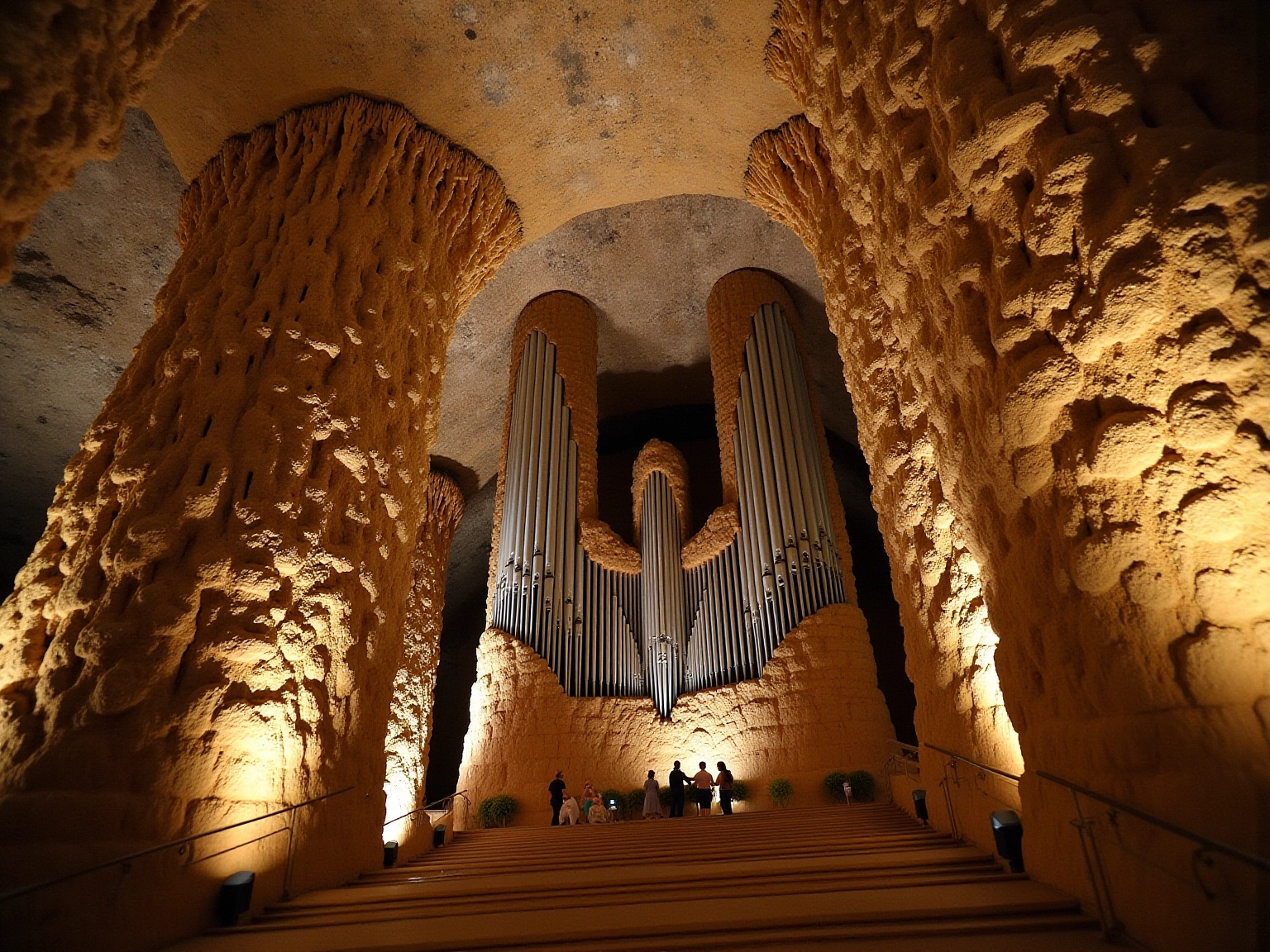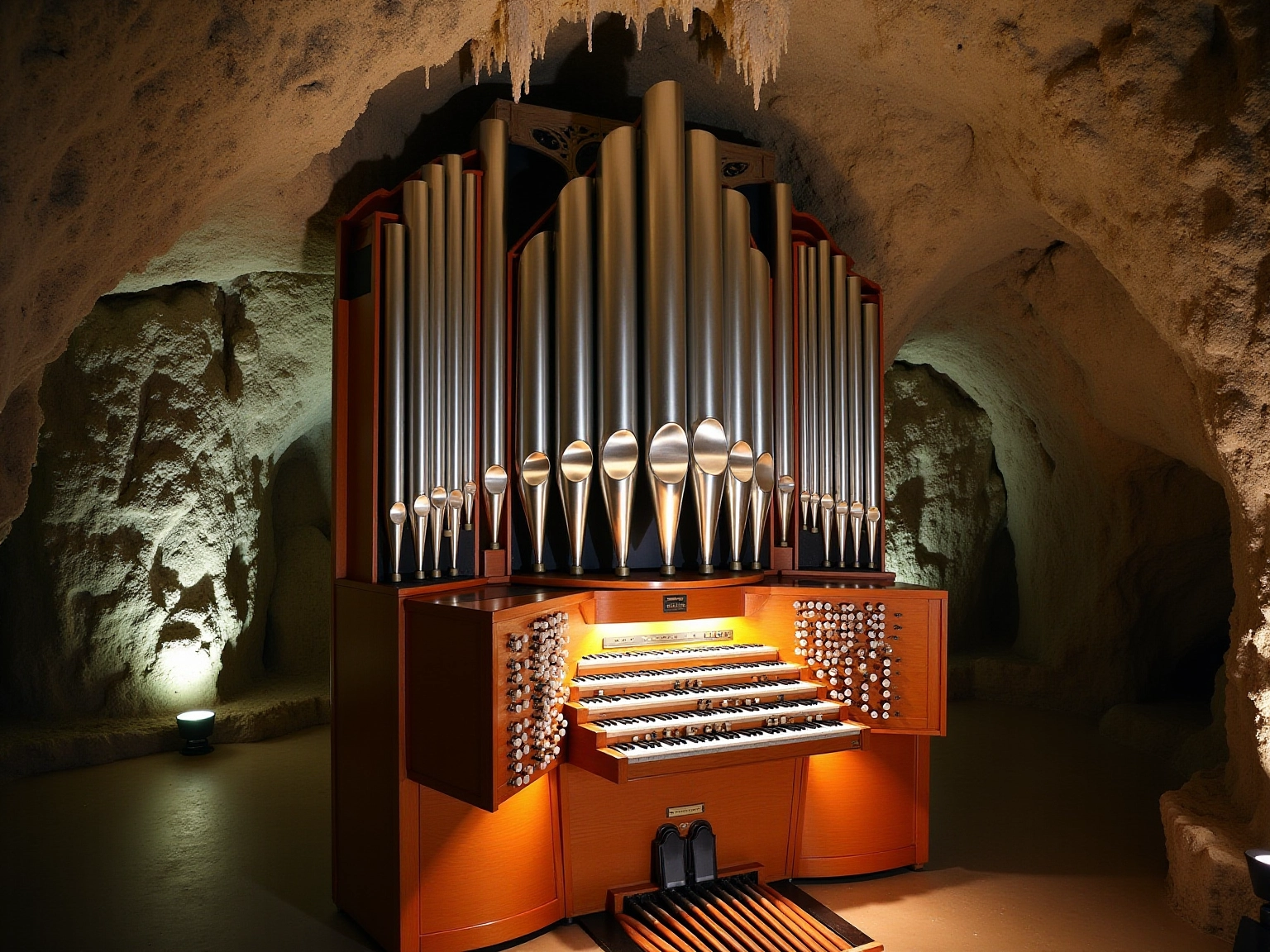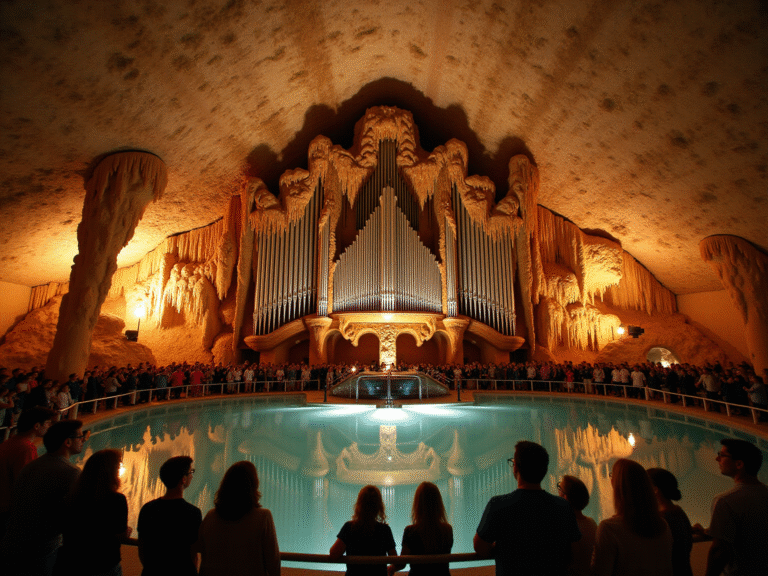Overview
Have you ever heard of the Great Stalacpipe Organ? Nestled in the enchanting Luray Caverns of Virginia, this incredible instrument is the largest of its kind in the world, stretching over 3.5 acres! Imagine the sound of electronic mallets gently striking stalactites to create music—it’s a truly unique experience!
What makes this organ so special? Well, not only does it produce 37 distinct tones, but it also has a fascinating cultural impact. You might even recognize its influence in popular media! Plus, there are ongoing efforts to preserve this musical marvel, ensuring that its legacy lives on for future generations to enjoy.
If you’re planning a visit, you won’t want to miss the chance to experience this extraordinary blend of nature and music. It’s a perfect example of how art and the environment can come together in harmony. So, why not add the Great Stalacpipe Organ to your travel itinerary? You’ll be glad you did!
Key Highlights:
- The Great Stalacpipe Organ, located in Luray Caverns, Virginia, is recognized as the world’s largest musical instrument, spanning over 3.5 acres.
- It is crafted from stalactites, producing sound through electronic mallets, creating a unique auditory experience with distinct reverberations.
- The organ’s construction was initiated by mathematician Leland W. Sprinkle between 1954 and 1957, utilizing natural acoustics of the caverns.
- It can produce 37 distinct tones, showcasing versatility from deep bass to high melodies, enhancing the immersive experience for visitors.
- The organ can be played manually or automatically, allowing for continuous musical performances throughout the year.
- The Luray Caverns, home to the organ, was designated a federal natural landmark in 1978, emphasizing the cultural and geological significance of the site.
- The instrument has influenced popular media, including the video game Fallout 3, highlighting its cultural impact beyond music.
- Efforts to preserve the organ are ongoing, ensuring its enjoyment for future generations and maintaining its musical integrity.
Introduction
Nestled within the enchanting Luray Caverns of Virginia is a marvel you simply can’t miss—the Great Stalacpipe Organ! It’s heralded as the world’s largest musical instrument, spanning an impressive 3.5 acres. This unique creation transforms natural stalactites into a symphony of sound, producing ethereal melodies that resonate through the cavern’s stunning acoustics.
Crafted by visionary mathematician Leland W. Sprinkle in the 1950s, this organ showcases the beautiful relationship between nature and music. It invites you to embark on an auditory journey that has captivated audiences for decades. Imagine the melodies intertwining with breathtaking geological formations! The Great Stalacpipe Organ stands as a testament to human creativity and the enduring power of musical expression, preserving the beauty of the natural world. Don’t you just want to experience it for yourself?
Defining the World’s Largest Musical Instrument
Have you ever heard of the Great Stalacpipe Organ? It is recognized as the biggest instrument in the world, and it’s truly a remarkable creation nestled within the stunning Luray Caverns of Virginia. Spanning over 3.5 acres, this incredible structure is crafted from stalactites—those natural mineral formations that have taken thousands of years to develop! Imagine the sound produced by striking these stalactites with electronic mallets, resulting in an ethereal musical experience that resonates throughout the cavern.
What’s fascinating is that the organ’s unique acoustics are so profound that some stalactites are positioned far enough away from the musician that it can take a full second for the sound to reach them. This creates a surreal auditory experience that you won’t forget! Recognized by Guinness World Records, this remarkable stalactite instrument is the biggest instrument in the world, exemplifying the harmonious blend of nature and music, and showing us how natural formations can be ingeniously transformed into a functional musical device.
Did you know that performances of lithophone music in Luray Caverns date back to at least 1880? That showcases the long-standing tradition of musical expression within this breathtaking natural setting. To tackle the unique acoustics and challenges of playing the Great Stalacpipe Organ, a machine similar to a player piano is often used to perform songs. This technology ensures steady musical performances, even when live musicians aren’t around, allowing visitors to appreciate the instrument’s music all year long.
As Tibi Puiu, a science journalist, beautifully puts it, “The instrument’s melodies intertwine with the stunning visuals of golden rock formations, crystalline limestone, and serene pools of water, crafting an almost surreal atmosphere.” This instrument not only serves as a testament to human creativity but also highlights the importance of preserving and appreciating the natural world through artistic expression. So, if you ever find yourself in Virginia, make sure to check out this incredible musical wonder!

Historical Context and Evolution of the Instrument
Have you ever heard of the Stalactite Instrument? Conceived in the 1950s by the talented mathematician Leland W. Sprinkle, this remarkable creation is a stunning blend of engineering and artistry! Sprinkle envisioned using the natural acoustics of the Luray Caverns, which led to the construction of the instrument from 1954 to 1957, and this innovative creation is acknowledged as the biggest instrument in the world! It employs solenoid-actuated rubber mallets to strike stalactites across a sprawling 3.5-acre area, producing 37 distinct tones that resonate beautifully throughout the cavern. Just imagine the sound filling the space around you!
The design of the Stalacpipe Organ not only showcases the potential of natural materials in music but also marks a pivotal moment in the evolution of musical instruments. Here, technology and nature come together to create an extraordinary auditory experience. It’s no wonder that the Great Stalacpipe Organ has received accolades from various national organizations and media outlets, including National Public Radio and ABC’s Good Morning America, solidifying its status as a testament to Sprinkle’s ingenuity.
Set against the backdrop of the Luray Caverns, which were designated a federal natural landmark in 1978, this instrument gains even more significance. Plus, modern creators like Paul Malmström of Pepe Deluxé have produced works such as ‘In The Cave,’ which highlight the instrument’s ongoing cultural influence. Isn’t it amazing how something created decades ago still resonates today?
And here’s a fun fact: the instrument can be played manually or automatically, allowing you to experience its unique sound throughout the cavern. So, if you ever find yourself in Luray, make sure to check it out—you won’t be disappointed!
Key Characteristics and Features of the Largest Instrument
The Great Stalacpipe Organ, recognized as the biggest instrument in the world, is truly a sight to behold, not just because of its impressive size but also due to its innovative design that uses stalactites as sound-producing elements. Imagine this remarkable instrument, which is the biggest instrument in the world, complete with a console featuring multiple keyboards that control electronic mallets to strike the stalactites and create beautiful sounds! Its musical versatility is nothing short of amazing, capable of producing a wide range of tones—from deep, resonant bass notes to soaring high melodies—offering you a rich auditory experience.
Nestled within the Luray Caverns, the organ’s unique position enhances its acoustic properties, allowing sound to reverberate throughout the expansive cave system. This creates an immersive experience for visitors, as the music fills the space without the need for loudspeakers—a feature you won’t find in most public musical instruments, making this structure even more extraordinary.
What’s even more fascinating is that expert insights highlight how the organ, as the biggest instrument in the world, showcases both engineering brilliance and artistic expression through its design and functionality. Larry Moyer, the Lead Engineer, has dedicated countless hours to preserving this incredible creation. He shares, “Over the decades, Moyer has toiled many late nights caring for the impressive musical instrument for the enjoyment of visitors.” This commitment ensures that the organ continues to delight audiences.
But the magnificent Stalactite Pipe Instrument is more than just a musical wonder; it serves as a cultural symbol, impacting popular media like the 2008 video game Fallout 3, which drew inspiration from the caves, underscoring its significance beyond geological value. The history of Luray Caverns is also compelling; it was purchased by the Luray Caverns Company in 1893, marking a pivotal moment in the site’s development.
With new formation deposits accumulating at a rate of about one cubic inch every 120 years, Luray Caverns remains an active geological site. This ongoing natural evolution adds another layer of intrigue to the stalactite instrument, making it a captivating subject for design enthusiasts and music lovers alike. So, are you ready to explore this extraordinary musical marvel?

Cultural and Musical Significance of the Instrument
Have you ever heard of the incredible stalactite musical instrument? It’s a true marvel of creativity and innovation, seamlessly blending sound with the natural beauty of its surroundings. Created by Leland W. Sprinkle in 1954, this extraordinary instrument attracts visitors from all over the world, offering a unique opportunity to experience music within the stunning acoustics of Luray Caverns.
The stalactites selected for this instrument are located in dry, non-growing areas of the cave, which helps them keep their tuning over time. As Larry Moyer, the operations manager for this remarkable creation, points out, ‘If they did grow, they’d go out of tune about every hundred years.’ This fascinating detail adds to the charm of the organ, which not only enhances the cultural landscape but also highlights the importance of preserving natural wonders while celebrating artistic expression.
The performances, often featuring classical compositions, showcase the organ’s versatility and its remarkable ability to evoke emotions in audiences. I love how Karen LeBlanc captures this sentiment when she says that every destination tells a story through its unique cultural elements, including music and art. The Great Stalacpipe Organ, recognized as the biggest instrument in the world, serves as a powerful reminder of music’s enduring ability to connect people with the natural world, enriching your visit in a truly memorable way. So, are you ready to experience this enchanting blend of music and nature for yourself?
Conclusion
The Great Stalacpipe Organ is truly a remarkable blend of nature and artistry, captivating you with its incredible ability to turn stalactites into beautiful melodies. Did you know it’s recognized as the world’s largest musical instrument? Spanning 3.5 acres in the enchanting Luray Caverns, this extraordinary creation showcases the amazing relationship between geological formations and musical expression. From its innovative design by Leland W. Sprinkle to its ongoing cultural significance, the organ is a fantastic example of what happens when human creativity harmonizes with the natural world.
But wait, there’s more! The organ isn’t just a musical marvel; it’s also a cultural icon. It influences various artistic expressions and draws visitors from all over the globe. With its unique acoustic properties, the Great Stalacpipe Organ offers an immersive auditory experience that resonates through the cavern, enhancing the beauty of the surrounding geological formations. This instrument reminds us of the importance of preserving natural wonders while honoring the artistic endeavors that celebrate them.
Ultimately, the Great Stalacpipe Organ is more than just an instrument; it symbolizes the enduring power of music to connect people and nature. By inviting you to experience its ethereal sounds, it fosters an appreciation for both the artistry involved in its creation and the natural beauty of the Luray Caverns. This extraordinary organ serves as a reminder of the creativity that can emerge when we engage with the environment, making it a must-visit destination for anyone eager to experience the harmonious blend of music and nature.
Frequently Asked Questions
What is the Great Stalacpipe Organ?
The Great Stalacpipe Organ is recognized as the biggest instrument in the world, located in the Luray Caverns of Virginia. It is crafted from stalactites, which are natural mineral formations that have developed over thousands of years.
How does the Great Stalacpipe Organ produce sound?
The organ produces sound by striking stalactites with electronic mallets, creating an ethereal musical experience that resonates throughout the cavern.
What makes the acoustics of the Great Stalacpipe Organ unique?
The organ’s unique acoustics are profound, with some stalactites positioned far enough away from the musician that it can take a full second for the sound to reach them, resulting in a surreal auditory experience.
When did performances of lithophone music in Luray Caverns begin?
Performances of lithophone music in Luray Caverns date back to at least 1880, showcasing a long-standing tradition of musical expression in this natural setting.
How are performances conducted on the Great Stalacpipe Organ?
A machine similar to a player piano is often used to perform songs on the organ, ensuring steady musical performances even when live musicians are not present.
What is the significance of the Great Stalacpipe Organ?
The Great Stalacpipe Organ exemplifies the harmonious blend of nature and music, transforming natural formations into a functional musical device, and highlights the importance of preserving and appreciating the natural world through artistic expression.


































